As Good Once as it Ever Was
by Brian Almeida
New In Chess Magazine, 2015/1, by New In Chess, 2015, 106pp. $12.99 (ChessCafe Price $11.04)
New In Chess Magazine has long been the world’s top chess magazine, and is now being billed as “The Club Player’s Magazine” at the New In Chess website. This seems to indicate they are trying to attract a broader audience, since I know of very few club players who even show an interest in the magazine and fewer still that actually subscribe. However, this is their loss because NIC is one of the few printed chess magazines still worth reading nowadays.

The content of issue 2015/1 is as follows:
- NIC’s Cafe
- Qatar Masters Open
- Burmese Days
- Quick, Quick, Slow
- Fair & Square
- Maximize Your Tactics
- The Inimitable Miguel Najdorf
- Healthy Optimism
- Chess as a Video Game
- Mind Games
- S.O.S. in the Four Knights
- Surprise Winner
- Sadler on Books
- Just Checking
“NIC’s Cafe” is the editorial teams spotlight of news tidbits. This issue features mentions of the movies The Imitation Game, based on the life of Alan Turing, and Life of a King, the true story of Eugene Brown, a former prison inmate who uses chess to inspire at risk inner-city kids. There is also a note of how chess played an important part in the creation of The Game of Throne novels by George R.R. Martin.

“Qatar Masters Open” is a tournament report by GM Robin van Kampen. It is described as follows: “How about this scenario? Top-seed Anish Giri bursts away with six straight wins until he is stopped by Vladimir Kramnik, who is playing his first Open in 21 years. The Russian also takes six games on the trot and takes over the lead. Game over? Not really. Enter former Junior World Champion Yu Yangyi. The Chinese GM beats both Giri and Kramnik in his last two games to claim another victory in his young and burgeoning career.” Beyond van Kampen’s report, there is an annotated game each from Giri, Kramnik, and Yangyi.
“Burmese Days” is part of Nigel Short’s “Short Stories” column. This time around he discusses his travels to the Myanmar Open.
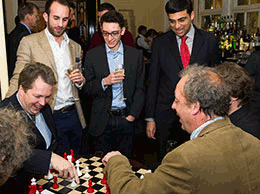
“Quick, Quick, Slow” refers to the three time controls used during the 6th London Chess Classic. Jonathan Speelman is the reporter on this one. The main event uses a football scoring system and was one in the last round by Viswanathan Anand over Giri and Kramnik; Nakamura won the Rapid ahead of Giri and Caruana; and Adams won the Blitz on tie-break ahead of Nakamura and Kramnik.
“Fair & Square” is the editorial teams spotlight of chess related quotes of note.
“Maximize Your Tactics” is a tactical solving page from GM Maxim Notkin in which nine positions from recent tournament practice are presented, with answers following later in the issue.
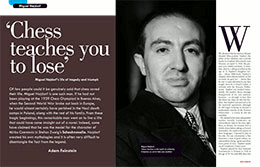
“The Inimitable Miguel Najdorf” is the cover story of the issue. The cover calls it a story of tragedy and triumph. Across a span of a little more than seven pages Adam Feinstein relates the life of Miguel Najdorf. From his birth as Mendel (Mieczyslaw) Najdorf, the loss of his family to the Nazis during World War II, his becoming trapped in Argentina with only $200 in his pocket, to his interactions with eleven of the nineteen world champions.
In “Healthy Optimism” Jan Timman analyzes two examples of Miguel Najdorf’s enterprising style of play.
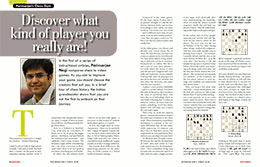
“Chess as a Video Game” finds Parimarjan Negi discussing how to improve your play by realizing what avatars suit you best as part of the feature “Parimarjan’s Chess Gym.”
“Mind Games” is the report from GM Maxime Vachier-Lagrave on the annual games festival in Beijing. This edition saw Alexander Grischuk and Hou Yifan shine in the chess section. There is an annotated game from each.
“S.O.S. in the Four Knights” sees Jeroen Bosch examining 4.h3!? in the Four Knights Defense as a way of avoiding the Berlin Wall. A line which Giri scored 2.5 out of 3 in the London Chess Classic.
“Surprise Winner” is Vladimir Barsky’s report on how Igor Lysyj became the new Russian champion, surrounded by masterworks painted by Nicolai Fechin at the Khazine National Art Gallery. With a game annotated by the tournament winner.
“Sadler on Books” finds GM Matthew Sadler reviewing five books this time out (often he only looks at two): The Modern Tiger, The Secret Life of Bad Bishops, Sveshnikov vs. the Anti-Sicilians, and gives brief mentions of Improve Your Chess Pattern Recognition and Chess Analytics. Is it any surprise that he absolutely loves every title published by New in Chess, or maybe that’s just how it appears to this reader.
“Just Checking” is the lighthearted question and answer column that is published on the back page of every issue. With standing question about favorite food and drink, colors, books, music, actors and actresses, and whether knowing how to play chess is actually useful in everyday life. This time Alejandro Ramirez checks in.
There are many lush photos throughout the issue, and an eye-catching multicolor layout adds to the professionalism of the magazine. Nevertheless, this issue feels flimsier than previous ones. Perhaps it is being printed on thinner paper, and the pages don’t look quite as glossy as they once did. Of note too is the fact that there seem to be fewer individual annotated games by the top players. They do seem to be making an effort to include more diagrams than ever; perhaps to make it more readable without a set and board at the ready, or to attract those elusive club players.
My assessment of this product:
![]()
Order New In Chess Magazine, 2015/1
by New In Chess
A PDF file of this week’s review, along with all previous reviews, is available in the ChessCafe.com Archives.
© 2015 ChessEdu.org. All Rights Reserved.
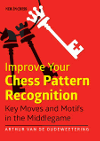
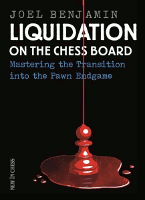
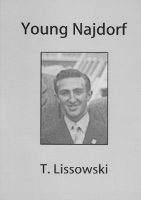
It’s probably the best Chess magazine around, but it’s very expensive to subscribe to. I try to read them at my local library. Sometimes I get some funny looks when the librarians see me reading the latest issue and also seeing me setting up the positions on my portable Chess set.
Nice! We’ve never seen one at a library.
the minneapolis(Minnesota) PUBLIC LIBARY carries NIC
magazine.